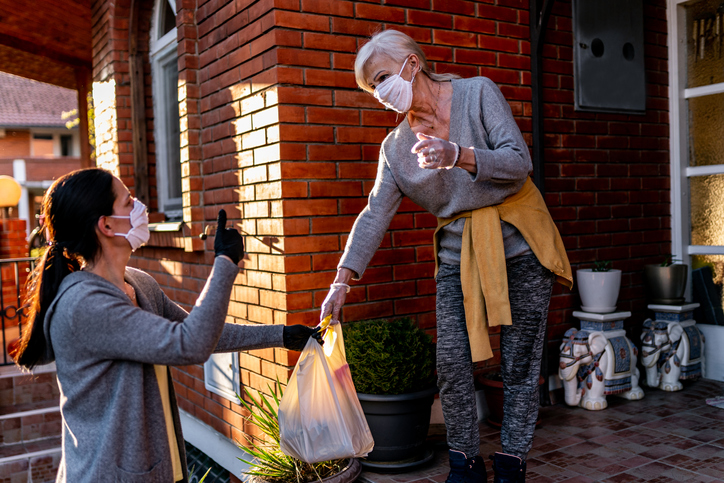The mortality rate of Covid-19 is rising with age. The cost of the economic shutdown declines with the number of people not subject to the shutdown. Consequently, there is a unique optimal cutoff age under which people should be free to carry out normal economic activity (if they want).

A complete shutdown, as some people advocate and some countries practice, may lead to an economic depression and civil unrest, looting, and a breakdown in law and order. Poor, desperate and hungry people may resort to looting, and the self-employed sector of the economy may be partly wiped out with grave social consequences.
A complete shutdown benefits older people with means at the expense of young people whose economic future is being ruined. Western governments are captured by older people—mostly bureaucrats—with steady incomes and guaranteed jobs (This also includes tenured university professors).
The impoverishment of the young and the independently employed cannot be remedied by taxing the old because a tax is merely a transfer while we are facing a dead-weight cost—a loss of GDP—that cannot be recovered by taxation. This cost increases with the length of the shutdown.
Here is a suggested alternative to a complete shutdown.
Facts: The mortality rate is rising with age; The cost of the economic shutdown declines with the number of people not subject to the shutdown.
Consequently, there is a unique optimal cutoff age under which people should be free to carry out normal economic activity (if they want).
| Age group | % dead of infected | Average | Pop. in mil | Expected dead, in mil | Value of life lost | ||
| S. Korea | Spain | Italy | |||||
| 15 to 19 | 0 | 0 | 0 | 0 | 21.1 | 0 | 0 |
| 20 to 29 | 0 | 0.22 | 0 | 0.07 | 45.4 | 0.02 | 0.17 |
| 30 to 39 | 0.11 | 0.14 | 0.3 | 0.18 | 43.7 | 0.04 | 0.4 |
| 40 to 49 | 0.08 | 0.3 | 0.4 | 0.26 | 40.5 | 0.05 | 0.53 |
| Sum | 150.7 | 0.11 | 1.09 | ||||
Table 1 presents illustrative calculations. Column (5) is the average mortality rate out of those infected by age group as reported by South Korea, Spain, and Italy. Column (7) calculates the expected number of deaths in the age group assuming that 50 percent of the people are infected if they are not subject to a shutdown.
Surely, social distancing and other measures to curb the infection can still be exercised. Column (8) calculates the loss in $ trillions as a result of the corona-related deaths in each age group. The calculation employs a statistical value of life of $10 million, which is used by the US Department of Transportation (August 8, 2016) and is consistent with Kniesner and Viscusi’s (2019) estimation.
It follows that removing the lockdown of people in the age groups of 15-19, 20-29, 30-39 and 40-49 will cost, in terms of life lost, $0, $0.17, $0.40 and $0.50 trillion, respectively, a total of $1.09 trillion. The population released in these age groups amounts to $150.7 million.
The cost of a complete shutdown is probably greater than $1.09 trillion in excess of the cost of a partial shutdown by which people in the 15-49 age group function normally.
Of course, finer data analysis is necessary to determine the optimal cutoff age above which it is economically worthwhile to have people locked up. We do not know the probability of contagion and infection in different age groups and the probability of death among those infected. One suspects that the reported probability of death among those infected is too high because of underreporting of the number of those infected.
The rest of the population will stay indoors until the pandemic subsides or until there is a cure or vaccination. Governments should provide efficient delivery services for the locked-in population, which is surely less costly than a complete shutdown.
In addition, there should be a staggered release of the population kept indoors, going from younger to older. This is because the mortality rate increases with the burden on the healthcare system (in particular, on intensive care units).
The size of the population groups released should be declining with age since the burden increases with the age of the patients.
The need to control the pace of release is because given the limited capacity of intensive care units: a person who chooses to undo the lockup creates an externality for others by potentially overburdening the healthcare system. This has been observed in Lombardy, Italy, where the flow of Covid-19 patients pushed the healthcare system toward collapse.
Anyone who is horrified at the cold calculation of life lost versus money earned should be reminded that we all as a society agree to have thousands of people killed every year in traffic accidents because we allow driving at 55 MPH instead of, say, 30 MPH.
We agree to kill people—potentially ourselves—in order to save us all time and money. The above calculation is no different. Also, not all of us drive the safest cars that are more costly.
Finally, on a light note, one is reminded of Gordon Gekko’s “greed is good” when observing the race among pharmaceutical companies to find a cure\vaccine\test for Covid-19. This gives us all hope.





